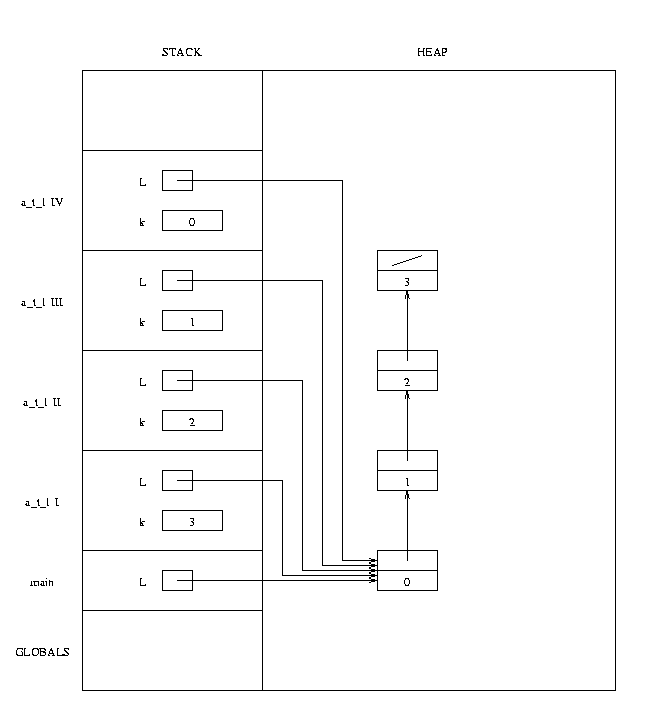Spring 2001, CSE 428: Solution of Test 3
Question 1 (Grammars)
-
- (4 ^ (2 * 3)) no
- 4 ^ 2 * 3 yes
- 4 ^ (2) no
- 16 no
- There are two kinds of ambiguity:
- Associativity of *
- Precedence between * and ^
An example of the first is:
Exp Exp
/|\ /|\
/ | \ / | \
Exp * Exp Exp * Exp
/|\ | | /|\
/ | \ | | / | \
Exp * Exp Num Num Exp * Exp
| | | | | |
| | | | | |
Num Num 4 2 Num Num
| | | |
| | | |
2 3 3 4
An example of the second is:
Exp Exp
/|\ /|\
/ | \ / | \
Exp ^ Num Exp * Exp
/|\ | | /|\
/ | \ | | / | \
Exp * Exp 4 Num Exp ^ Num
| | | | |
| | | | |
Num Num 2 Num 4
| | |
| | |
2 3 3
-
Exp ::= Exp * A | A
A ::= A ^ Num | Num | (Exp)
Num ::= 0 | 1 | 2 | 3 | 4 | 5 | 6 | 7 | 8 | 9
Question 2 (Parameter passing methods)
- Call by value 1
- Call by reference 3
- Call by value-result 2
Question 3 (Memory management)

Question 4 (Concurrency in Java)
class Merge extends Thread{
private Queue q1,q2,q3; //Input queues and output queue
public Merge(Queue p1, Queue p2, Queue p3){ q1 = p1; q2 = p2; q3 = p3; }
public void run() {
for(;;){
boolAndInt x;
x = q1.pop();
if (x.getBool()) q3.insert(x.getInt());
x = q2.pop();
if (x.getBool()) q3.insert(x.getInt());
}
}
}
class Queue {
private class Element{
public int info;
public Element next;
public Element(int n,Element e){ info = n; next = e; }
}
private Element first, last;
public Queue() { first = last = null; }
public synchronized boolAndInt pop() {
boolAndInt x = new boolAndInt();
if (first == null) {
x.setBool(false);
x.setInt(0);
return x;
}
else {
x.setBool(true);
x.setInt(first.info);
first = first.next;
if (first==null) last = null;
return x;
}
}
public synchronized void insert(int n) {
if (first == null)
last = first = new Element(n,null);
else
last = last.next = new Element(n,null);
}
}
class boolAndInt {
private int n;
private boolean b;
public int getInt() { return n; }
public boolean getBool() { return b; }
public void setInt(int k) { n = k; }
public void setBool(boolean c) { b = c; }
}
Question 5 (Higher Order in ML)
fun exists L p = reduce (fn (x,y) => p(x) orelse y) false L;
fun forall L p = reduce (fn (x,y) => p(x) andalso y) true L;
Question 6 (ML - Data types)
This question can be solved by using a queue in a way similar to the standard algorithm for the breadth-first traversal of the tree (or traversal by levels). Let us remind this algorithm first.
fun aux [] = []
| aux (leaf x :: L) = x :: aux L
| aux (node(t1,x,t2)::L) = x :: aux(L @ [t1,t2]);
fun bftrav t = aux [t]; (* returns the breadth-first traversal of t *)
Let us now solve the intended problem. We will use an auxiliary function
split which returns the last two elements of a list, and the rest of the list.
fun split [x1,x2] = ([],x1,x2)
| split (x :: L) = let val (K,x1,x2) = split L
in (x::K,x1,x2)
end;
fun auxil [] n = []
| auxil (leaf x :: L) n = leaf n :: auxil L (n+1)
| auxil (node(t1,x,t2) :: L) n = let val (K,u1,u2) = split (auxil (L @ [t1,t2]) (n+1))
in node(u1,n,u2) :: K
end;
fun enumerate t = hd (auxil [t] 1);
Question 7 (ML - Data types)
fun numnodes(t,1) = 1
| numnodes(leaf x,n) = 0
| numnodes(node(t1,x,t2),n) = numnodes(t1,n-1) + numnodes(t2,n-1);
Question 8 (Prolog)
solutions(M,N,X,Y) :- nat(X,M), nat(Y,M), M is X + Y, N is X * Y.
nat(X,M) :- M >=0, X is M. /* gives all possible integers between 0 and M */
nat(X,M) :- M > 0, N is M - 1, nat(X,N).
Question 9 (Prolog)
flatten([],[]).
flatten([X|L],[X|K]) :- not(list(X)), flatten(L,K).
flatten([X|L],K) :- list(X), flatten(X,K1), flatten(L,K2), append(K1,K2,K).
list([]).
list([_|_]).
Question 10 (Prolog)
merge([],L,L).
merge(L,[],L).
merge([X|L],[Y|K],[X|M]) :- merge(L,[Y|K],M).
merge([X|L],[Y|K],[Y|M]) :- merge([X|L],K,M).
